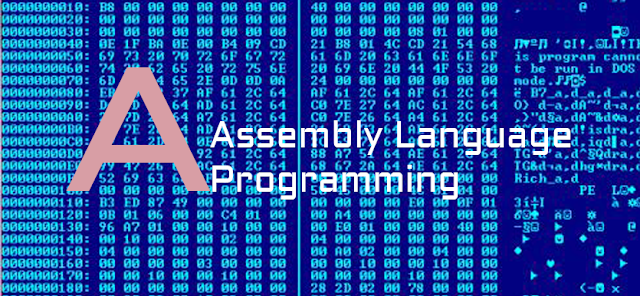Assembly Language programming : 8086 Assembler Tutorial (Part 10)
Macros
Macros are just like procedures, but not really. Macros look like procedures, but they exist only until your code is compiled, after compilation all macros are replaced with real instructions. If you declared a macro and never used it in your code, compiler will simply ignore it. emu8086.inc is a good example of how macros can be used, this file contains several macros to make coding easier for you.
Unlike procedures, macros should be defined above the code that uses it, for example:
The above code is expanded into:
MOV AX, 00001h
MOV BX, 00002h
MOV CX, 00003h
MOV AX, 00004h
MOV BX, 00005h
MOV CX, DX
Macros are expanded directly in code, therefore if there are labels inside the macro definition you may get "Duplicate declaration" error when macro is used for twice or more. To avoid such problem, use LOCAL directive followed by names of variables, labels or procedure names. For example:
If you plan to use your macros in several programs, it may be a good idea to place all macros in a separate file. Place that file in Inc folder and use INCLUDE file-name directive to use macros. See Library of common functions - emu8086.inc for an example of such file.

Assembly Language : 8086 Assembler Tutorial Part 12
Assembly Language : 8086 Assembler Tutorial Part 11
Assembly Language : 8086 Assembler Tutorial Part 10
Assembly Language : 8086 Assembler Tutorial Part 9
Assembly Language : 8086 Assembler Tutorial Part 8
Assembly Language : 8086 Assembler Tutorial Part 7
Assembly Language : 8086 Assembler Tutorial Part 6
Assembly Language : 8086 Assembler Tutorial Part 5
Assembly Language : 8086 Assembler Tutorial Part 4
Assembly Language : 8086 Assembler Tutorial Part 3
Assembly Language : 8086 Assembler Tutorial Part 2
Assembly Language : 8086 Assembler Tutorial Part 1
Assembly Language Programming : Complete 8086 instruction sets
Assembly Language Programming : I/O ports - IN/OUT instructions
Assembly Language programming : Emu8086 Assembler Compiling and MASM / TASM compatibility
Assembly Language - string convert - Lowercase , Uppercase
for programming : the language of Number
Assembly Language - Complete Instruction Set and Instruction Timing of 8086 microprocessors
Assembly Language programming : A list of emulator supported interrupts
Assembly Language Programming : Emu8086 Overview, Using Emulator, Virtual Drives
Assembly Language Programming : All about Memory - Global Memory Table and Custom Memory Map
buy me a cup of coffee
buy me a cup of coffee
Need More Detail ? contact me !!
Send me any small amount of money is welcome.
___________________________________________
Don't know how to send money ? Click here for detail about Paypal account.
About PayPal Payment Methods
What type of PayPal accounts is better.
Don't have money? OK! Here is another way to get the program.
how to get my program - Free of charge

Macros
Macros are just like procedures, but not really. Macros look like procedures, but they exist only until your code is compiled, after compilation all macros are replaced with real instructions. If you declared a macro and never used it in your code, compiler will simply ignore it. emu8086.inc is a good example of how macros can be used, this file contains several macros to make coding easier for you.
Macro definition:
name MACRO [parameters,...]
<instructions>
ENDM
|
Unlike procedures, macros should be defined above the code that uses it, for example:
MyMacro MACRO p1, p2, p3
MOV AX, p1
MOV BX, p2
MOV CX, p3
ENDM
ORG 100h
MyMacro 1, 2, 3
MyMacro 4, 5, DX
RET
|
The above code is expanded into:
MOV AX, 00001h
MOV BX, 00002h
MOV CX, 00003h
MOV AX, 00004h
MOV BX, 00005h
MOV CX, DX
Some important facts about macros and procedures:
|
Macros are expanded directly in code, therefore if there are labels inside the macro definition you may get "Duplicate declaration" error when macro is used for twice or more. To avoid such problem, use LOCAL directive followed by names of variables, labels or procedure names. For example:
MyMacro2 MACRO
LOCAL label1, label2
CMP AX, 2
JE label1
CMP AX, 3
JE label2
label1:
INC AX
label2:
ADD AX, 2
ENDM
ORG 100h
MyMacro2
MyMacro2
RET
|
If you plan to use your macros in several programs, it may be a good idea to place all macros in a separate file. Place that file in Inc folder and use INCLUDE file-name directive to use macros. See Library of common functions - emu8086.inc for an example of such file.

emu8086 is better than NASM, MASM or TASM
Tag: 8086 Assembler, 8086 microprocessors instruction, assembly code, Assembly coding, assembly guide, assembly instruction, assembly language, assembly language instruction set, assembly language programming, Assembly program, assembly programming, capital letter, character convert, complete 8086 instruction sets microprocessors, complete instruction timing and instruction sets for 8086 microprocessors, conversion of characters in assembly language programming 8086, convert, emu8086, instruction complete set, instruction set complete for 8086, instruction sets, instruction sets for 8086, Lower case, Lowercase, print the small character into capital letter, programming 8086 assembly language conversion of small characters to capital, small letter, text string convert, Tutorial,Assembly Language : 8086 Assembler Tutorial Part 12
Assembly Language : 8086 Assembler Tutorial Part 11
Assembly Language : 8086 Assembler Tutorial Part 10
Assembly Language : 8086 Assembler Tutorial Part 9
Assembly Language : 8086 Assembler Tutorial Part 8
Assembly Language : 8086 Assembler Tutorial Part 7
Assembly Language : 8086 Assembler Tutorial Part 6
Assembly Language : 8086 Assembler Tutorial Part 5
Assembly Language : 8086 Assembler Tutorial Part 4
Assembly Language : 8086 Assembler Tutorial Part 3
Assembly Language : 8086 Assembler Tutorial Part 2
Assembly Language : 8086 Assembler Tutorial Part 1
Assembly Language Programming : Complete 8086 instruction sets
Assembly Language Programming : I/O ports - IN/OUT instructions
Assembly Language programming : Emu8086 Assembler Compiling and MASM / TASM compatibility
Assembly Language - string convert - Lowercase , Uppercase
for programming : the language of Number
Assembly Language - Complete Instruction Set and Instruction Timing of 8086 microprocessors
Assembly Language programming : A list of emulator supported interrupts
Assembly Language Programming : Emu8086 Overview, Using Emulator, Virtual Drives
Assembly Language Programming : All about Memory - Global Memory Table and Custom Memory Map
buy me a cup of coffee
My Paypal Account is : ksw.industries@gmail.com
Send me any small amount of money is welcome.buy me a cup of coffee
___________________________________________
Need More Detail ? contact me !!
My Paypal Account is : ksw.industries@gmail.com
buy me a cup of coffeeSend me any small amount of money is welcome.
___________________________________________
Don't know how to send money ? Click here for detail about Paypal account.
About PayPal Payment Methods
What type of PayPal accounts is better.
Don't have money? OK! Here is another way to get the program.
how to get my program - Free of charge

No comments:
Post a Comment